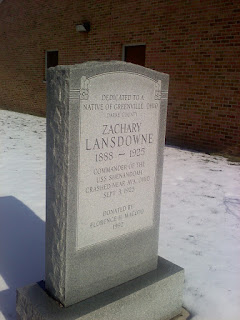 |
| Pioneer Cemetery and Brown's marker near Lunken |
Pioneer Cemetery near
Lunken Airport is the site of the 1st settlement called Columbia in 1788 that would later become modern Cincinnati. The man who led that landing, Benjamin Stites, is buried here along with many other of those early pioneers.
Sgt. William Brown (1764-1804) a member of the
5th Connecticut Regiment in the Revolutionary War received the newly created
Badge of Military Merit by George Washington in May of 1783. It was a purple cloth badge. Only 3 were awarded (the other two were
Sergeant Elijah Churchill and
Sergeant Daniel Bissell) and none were given again until it was later re-named in WWI to the
Purple Heart as a revival of the original badge. While not entirely clear, it is believed that the badge
1781 Siege of Yorktown. Only two of these badges are known to have survived. Brown's was found in the 1920's in an old barn and is currently in the possession of
The Society of the Cincinnati, New Hampshire Branch. Brown, like many other Revolutionary War veterans seeking cheap land, eventually settled in the newly developed booming river-town of Cincinnati OH where he lived and later died.
was awarded for Browns efforts in the
 |
| recently renovated Fulton Cemetery |
So where is Sgt Brown's body? It’s not here with the marker. In 2004, the marker seen in my above photo was placed in the nicer maintained
Pioneer Cemetery where others from this time period are buried. His body was thought to be about 1000 ft away next to some old railroad tracks in what was the once weed-filled and trash strewn forgotten
Fulton Cemetery with no legible tombstones. I actually tried to locate Fulton once to no avail. It was that bad and a bit dangerous. However in early 2011, thanks to a geocache that led me back to the area, I discovered that because of the
Ohio River Trail Bike Path that was extended past the older unkempt cemetery, it generated an interest in renovating the old cemetery. On my second visit, it was easy to locate and I saw they placed new markers for the seven other Revolutionary War Veterans buried in Fulton. The volunteers of the
Cincinnati Preservation Association also tried to reassemble the old tombstones for these men as best as they could but all are badly worn and mostly unreadable. They also added some nice historical plaques about the old cemeteries, the Purple Heart, the Flood of 1937, the railroad and Columbia at the Carrel Street Station next to the new bike path.
 |
| some of the original Fulton tombstones |
It is nice to see the efforts of the many individuals to honor and respect Brown and these other men who fought for their new country.
There are more pictures of the Pioneer Cemetery
here and the Fulton Cemetery
here.





